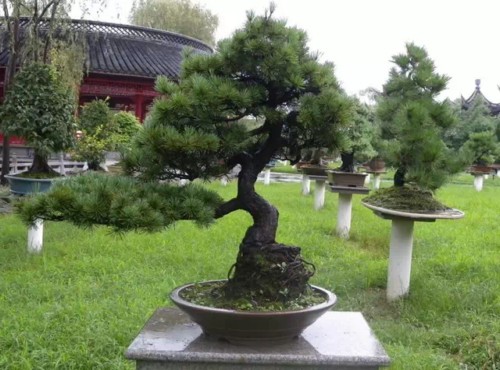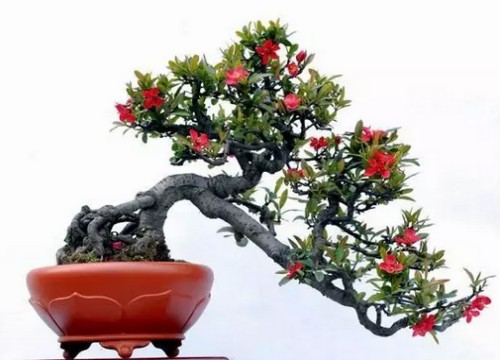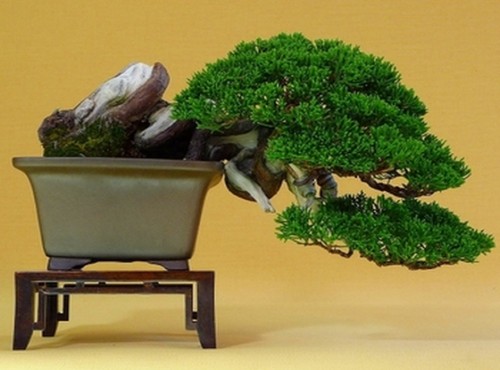Fertilization skills of Pine Bonsai in Spring and Autumn
In the wild, most pine trees grow in poor ridges or high altitude areas, and are pioneer species of positive (good sunlight), which means that pine trees can grow well without using too much fertilizer. Horticulture in order to enable the tree to grow quickly and shorten the cultivation time, we amateur players, especially us amateur players, do not hesitate to fertilize and wish the tree could grow an inch in a night.

Pine pots are usually fertilized twice a year (finished trees are only fertilized in autumn, but it is best to apply fertilizer before sprouting to promote the growth of new buds).
Spring fertilizer: mainly long buds and long leaves
If the tree is weak, it can be fertilized earlier, and the time is about 2 ~ 3 months after budding. Since the tree is weak, it cannot and does not need to apply too much fertilizer at one time.
The tree is strong a little later, and the time is about 3-5 months before budding after leaf spreading. Too early can easily lead to overgrowth or excessive Internode length. Although the Internode is too long, the Internode can be shortened by picking (or cutting) buds, but the growth is too strong and the direct sunlight is not enough, and the new buds are likely to grow above 10~750px before they begin to spread their leaves, because the pine tree only grows buds where there are fixed buds (leaf base). In this section, there are no leaves to force the buds, shorten the Internode, and finally only cut off the whole branch (or remove all the green buds). Start all over again (it is often seen in the flower market that there is a very long trunk without leaves, so it is estimated that all the branches growing in the same period have the problem of overlong internodes).
Autumn fertilizer: mainly because the branches are long and thick.
In late summer and early autumn, about August to September, the weather began to cool, and the pine trees began to grow rapidly after summer dormancy. Generally speaking, autumn fertilizer must be under, autumn fertilizer absorption is not enough, the next spring bud growth will not be good, affecting the growth of the whole year.
When the temperature is too high in summer and the sun is weak in winter, the growth of pine trees slows down (the cells growing in summer are as big or even larger as those in spring and autumn, and the slow growth in summer can not be seen from the ring). There is no need for (too much) fertilizer, especially under the full sunshine in summer, the water evaporates quickly, and if too much fertilizer remains in the basin soil, it may be because of water evaporation. The concentration of ions (fertilizer) in the water increases sharply, causing fertilizer injury, even if it does not reach the degree of fertilizer injury, it will reduce the ability of plants to absorb water because of osmotic pressure, and reduce the cooling effect of pine trees when the temperature is high, especially by evapotranspiration.
After changing the basin, it is best to apply fertilizer at an interval of 1 to 2 months. If you miss the opportunity, it doesn't matter if you don't apply fertilizer next time (only pulling out the pot without removing the soil, you can apply fertilizer in accordance with the timing of fertilization in the Spring and Autumn period a week later, but it should not affect the extension of the new root excessively).
Time: 2019-06-12 Click:
- Prev

The corrective method of bonsai root
The longer the pot is cultivated, the more beautiful the root plate will be, so the age and age of the pot tree can be judged by the root plate. In order to make a potted plant with a good root plate, it is necessary to use a shallow basin to pile the soil slightly higher than the basin surface, so that the root straddles the high basin soil, slightly exposes the soil surface, expands in all directions, and is exposed to the sun to accelerate its growth and change.
- Next

Notes on Fertilization of Pine Bonsai
After applying organic fertilizer for a few days, white mycelium can often be seen growing from the fertilizer, which is mostly considered to be that the fertilizer is not completely decomposed. After decomposition, the raw material will become powder. For some reasons (maybe bagging, ease of application, aesthetics, etc.), the manufacturer will make the fertilizer into granules. In this process,
Related
- Fuxing push coffee new agricultural production and marketing class: lack of small-scale processing plants
- Jujube rice field leisure farm deep ploughing Yilan for five years to create a space for organic food and play
- Nongyu Farm-A trial of organic papaya for brave women with advanced technology
- Four points for attention in the prevention and control of diseases and insect pests of edible fungi
- How to add nutrient solution to Edible Fungi
- Is there any good way to control edible fungus mites?
- Open Inoculation Technology of Edible Fungi
- Is there any clever way to use fertilizer for edible fungus in winter?
- What agents are used to kill the pathogens of edible fungi in the mushroom shed?
- Rapid drying of Edible Fungi

